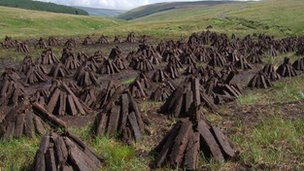In the autumn and winter, one smell tells Irish people returning from abroad that they are home. It isn’t tea steeping or soda bread baking. It isn’t even the smell of a hot whiskey. A turf fire burning in the grate is what smells like home to anyone who has spent a few winters in Ireland. It’s the smell of the Irish gift of hospitality that speaks of cozy cottages, damp fields, laughter around a packed table. The crackle of wood fire might be say welcome home to people in North America, and for Irish-Americans down under, winter might be marked with the sizzle of a barbeque. Coal is used more in England, Scotland and Wales. But in Ireland, while you will see and smell wood and coal fires in homes, it is the smell of turf burning that people get sentimental about.
What exactly is turf? Turf is the natural product of Irish bogs. It is technically a fossil fuel, not ordinary dirt. Turf is also known as peat, but what is cut out of bogs and burned is not what you will find at the garden nursery labeled ‘peat moss.’ The bogs are an acidic environment, which keeps dead vegetation from decaying completely. The semi-decayed, semi-preserved material is turf. (The bogs also yield some amazing preserved remains of ancient people and their artifacts because they prevent total decay of organic matter.) More than 15% of land in Ireland is bog, according to the Irish Wildlife Trust, and the midlands in particular are known for their bogs. People from rural parts of the Irish midlands are teasingly called ‘boggers’ by people from Dublin and other Irish cities.
Traditionally, turf is cut in rectangles called sods previously by hand and now by machine. These are left in stacks in the bog to dry so they can be burned. In small towns and rural areas, it is common to see tractors pulling carts full of sods of turf and delivering them to homes. A family would typically get a cartful of turf delivered in August or early September to heat their home for the winter. In more urban areas, it is more common for people to buy turf as pressed briquettes, which produce less smoke than sods.
Regulations now protect some bog land because so much turf has been cut over time that the bog’s role as a natural habitat for many animals and plants is in danger. Once it was common to see Irish gifts made of pressed turf, but today the same look is often created in resin, which helps protect the bogs.
The bogs have been a rich source of many Irish gifts – from our history and heritage to our heating. They are home to a huge range of creatures from frogs and dragonflies to otter and hare to birds such as the curlew and red grouse. Irish bogs are part of our history, a practical part of our present and hopefully also a gift to future generations.

